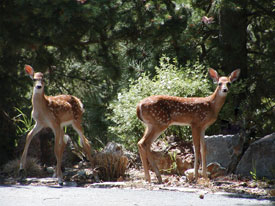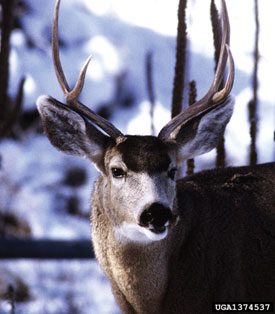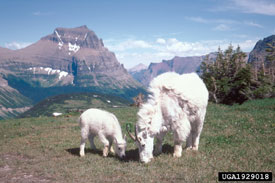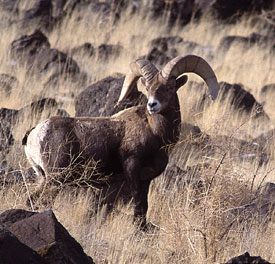Mammals
Grizzly bears | Black bears | Gray wolf | Bison | Moose | Elk | Caribou | White-tailed deer | Mule deer | Mountain goats | Bighorn sheep |
Humans share some distinguishing characteristics with the watershed’s other mammals. In general, we are all sexually dimorphic (males and females differ in appearance, size, or other features), bear live young and nurse them, have hair or fur on our bodies, and are endothermic (absorb heat energy). Mammals can be carnivores (meat eaters), herbivores (plant eaters), omnivores (animal and plant eaters), or insectivores (insect eaters).
Some mammals found in the Flathead Watershed include grizzly bear, black bear, bison, moose, elk (also known as wapiti), caribou, mule deer, white-tailed deer, pronghorn, mountain goat, bighorn sheep, gray wolf, cougar, coyote, grey fox, red fox, mountain lion, Canada lynx, bobcat, raccoon, wolverine, badger, river otter, fisher, marten, mink, weasel, skunk, white-tailed jackrabbit, mountain cottontail, snowshoe hare, pika, porcupine, beaver, muskrat, hoary marmot, yellow-bellied marmot, northern flying squirrel, red squirrel, Columbian ground squirrel, golden-mantled ground squirrel, red-tailed chipmunk, yellow-pine chipmunk, least chipmunk, montane vole, meadow vole, northern pocket gopher, bog lemming, deer mouse, house mouse, Norway rat, pygmy shrew, water shrew, and several bats to name a few.
It is easy to see from this partial list that the Flathead Watershed includes important habitat for a wide assortment of species. Because the territories encompassing the watershed vary greatly, distinctive populations and combinations of these mammals also vary widely throughout the watershed.
 |
Figure 2.49: Grizzly bear. Source: Todd Berget |
Grizzly bears (Ursus arctos)
Grizzly bears are the second largest mammal—behind the bison—in the Flathead Watershed, standing 6 to 8 feet (1.8 – 2.4 m) and weighing an average 285 pounds (130 kg) for females and 400 pounds (200 kg) for males. They have a round head with a “dish-shaped” face, a pale yellow to dark brown coat, long front claws, and a prominent hump behind their neck at the shoulder. These magnificent animals require huge home territories—up to 193 square miles (500 km2 for males)—though they now occupy only one percent of their historic range in the lower 48 states.
In North America, grizzly bears previously ranged from Alaska to Mexico and as far east as the Hudson Bay area. Grizzlies traveled to North America from where they originated in Eurasia approximately 50,000 years ago. Space to roam, thick undergrowth, diverse food, and liberal rainfall have bestowed the North Fork of the Flathead with the highest density of inland grizzly bears in North America. Here, populations of grizzlies from Canada and the U.S. maintain important genetic linkages across the international border. The grizzly bear is Blue-listed in the SRMMP where it has been studied since the 1970s. The species was listed as threatened under the U.S. ESA in 1975 and the Grizzly Bear Recovery Plan was established. A large portion of the Flathead Watershed is included in the Northern Continental Divide Ecosystem (NCDE) recovery zone (of which there are six) for grizzly bears.
Critical recovery goal targets—such as distribution of females, numbers of females with cubs, female mortality, and human-grizzly bear interfaces—are monitored in the recovery zones. Ongoing research and monitoring have shown fluctuating data about grizzly populations since 1987. In 1998, scientists from the USGS Biological Resources Division Glacier Field Station in Glacier National Park began conducting DNA research to more accurately establish populations in the park.
Special Order in Grizzly Country
National Forest Service
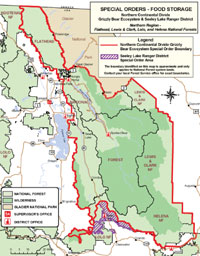 |
Figure 2.50: Special Order Boundary. Source: U.S. Forest Service |
In an effort to promote human-grizzly bear coexistence and to minimize conflict, The Interagency Grizzly Bear Committee developed a Special Order. The order defines several important compliance requirements.
All attractants – food and beverages (including canned food, pop, and beer), grease, garbage, livestock, and pet food (except hay and water), and scented or flavored toiletries (like toothpaste and Chapstick) – must be made unavailable to bears when your camp or picnic site is unattended.
- Store in a hard-sided camper, vehicle trunk or cab.
- Hang attractants at least 10 feet off the ground and 4 feet away from any vertical support, like a tree.
- Store in a bear resistant container. An equipment loan program offers a limited number of bear resistant panniers, backpacker food tubes, and rope & pulley hoisting systems.
Coolers, pop-up campers, tents, backpacks, and plastic boxes are NOT considered resistant. For more information about storing your food, the equipment loan program and the special order, contact: Flathead National Forest, 406.758.5204.
Black bear (Ursus americanus)
Black Bear are found in high densities in northwestern Montana, and play an essential role in the watershed. Their fur is most often black, but can also be cinnamon brown, or blonde. Dense forests and secure areas isolated from human activity are important for their survival. Because they are opportunistic feeders (eating a variety of available foods), their distribution is influenced by food availability.
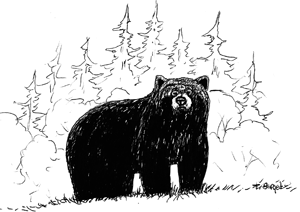 |
| Figure 2.52: Black Bear. Source: Todd Berget |
For many years, black bears were encouraged by park rangers to feast on garbage and were even fed for the entertainment of National Park visitors. For the safety of park visitors and the long-term survival of bears, this practice was halted. We now know that bears learn and remember where they find food and will return systematically to those locations.
Unfortunately, a learned tolerance of humans and attraction to human food and garbage, pet food and bird seed, has led to numerous human-black bear conflicts. Even when natural food sources are plentiful, a bear can more efficiently obtain its caloric intake by raiding one trash can full of leftovers than it can by finding and consuming huckleberries. This habituation (the decrease in behavioral response to humans after repeated exposure) leads to poor nutrition, property damage and human injury, and has resulted in “problem” bears being relocated or destroyed.
As rural lands at the forest-wildland interface continue to be developed, it has become increasingly vital for people to learn to avoid behaviors that attract bears. Bear-safe trash containers and proper storage of attractants such as pet food and wild bird food are critical for human safety and the bear’s survival.
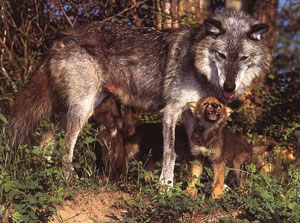 |
Figure 2.53: Wolf with pups. Source: All About Wolves
|
Gray wolf (Canis lupus)
The Gray Wolf was essentially driven to extinction in the Flathead Watershed and the rest of the U.S. in the early 1900s. In 1967, the U.S. Fish & Wildlife Service listed the eastern timber wolf (Canis lupus lycaon) as endangered, and six years later in 1973 listed the northern Rocky Mountain subspecies (Canis lupus irremotus) as endangered. In 1995, a long-planned effort was implemented to reintroduce wolves in recovery areas in northwestern Montana, Central Idaho, and the Greater Yellowstone. But in 1979—long before this reintroduction—wolves from Canada began to naturally recolonize the North Fork of the Flathead Watershed just northwest of Glacier National Park in B.C. The first documented den and litter of pups in over 50 years in Montana was subsequently found in the park in 1986.
The small wolf population has slowly grown as a result of natural reproduction and dispersal. Some of these wolves have migrated as far as 500 miles (800 km) north into Alberta, and as far south as Yellowstone National Park. Gray wolves weigh on an average of 80 to 100 pounds (36 to 47 kg), with males weighing more than females. Females grow to approximately 70 inches (180 cm) while males can be slightly larger at 73 inches (186 cm). The wolves of the Flathead Watershed tend to be either black, grayish brown, or several shades between gray and black.
Like all predators, the gray wolf plays an essential role in maintaining the health of ecosystems. By preventing large herds of herbivores like deer and elk from becoming overpopulated, wolves help maintain biodiversity. By culling herds that would otherwise damage sensitive meadows and wetlands, wolves keep predation by herbivores in check which in turn keeps riparian vegetation healthy which provides optimum habitat for birds, fish, and other species. They also help to limit coyote populations. Many native cultures include the wolf in their everyday rituals and spiritual lives.
“I now suspect that just as a deer herd lives in mortal fear of its wolves, so does a mountain live in mortal fear of its deer. And perhaps with better cause, for while a buck pulled down by wolves can be replaced in two or three years, a range pulled down by too many deer may fail of replacement in as many decades.”
- Aldo Leopold
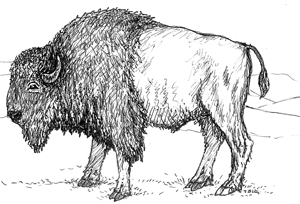 |
| Figure 2.54: Bison. Source: Todd Berget |
Where an estimated 60 million bison once grazed the North American plains in the seventeenth century, they were slaughtered—primarily for sport—until 1890 when fewer than 1,000 animals survived. Their grazing and movement through the territory once helped to distribute and determine the location and growth of grassland vegetation. Bison are now restricted to the National Bison Range in Montana and are found in small herds in Waterton Lakes National Park. Administered by the U.S. Fish and Wildlife Service as part of the National Wildlife Refuge System, the National Bison Range is home to between 350 and 500 bison.
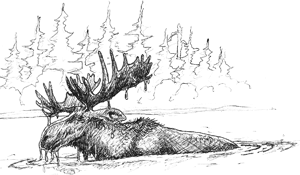 |
| Figure 2.55: Moose. Source: Todd Berget |
The largest member of the deer family, the moose (Alces alces), survives well in the deep snow of high altitude coniferous, deciduous, and mixed forests, as well as the wet bogs, lakes, and riparian areas at low altitudes. They stand 5 to 6 feet (1.5 to 1.8 m) tall and are 6.5 to 9 feet (2 to 2.7 m) in length. Moose find nourishment browsing on trees and shrubs, and grazing on grasses and other terrestrial and aquatic plants. Their strong, long legs allow them to move with ease through up to 30 inches (76.2 cm) of snow.
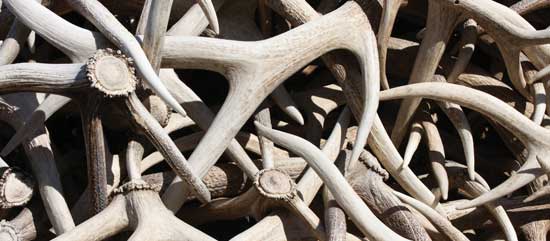 |
| Figure 2.62: Stack of elk antlers. Source: Tammy Venable |

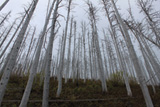

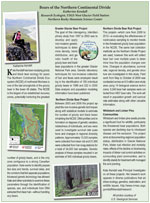
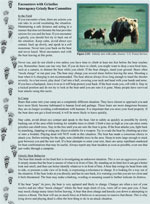
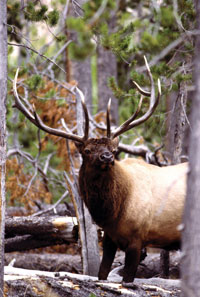
_flat.jpg)
